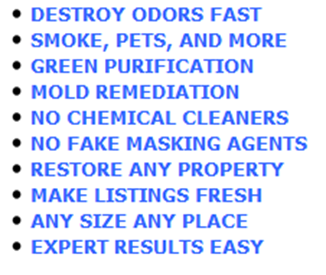

Mold, mildew, and fungus can be oxidized with ozone. Heritage Air ozone generators reduce or eliminate the ability for the exposed mold, mildew and fungus to grow as well as oxidizing the existing mold. Mold and mildew grow in dark and humid places where there is a lack of fresh oxygen. In all cases the moisture and humidity in the walls, floor etc., must first be removed or solved permanently to effectively eliminate the problem mold and odor. Once moisture is removed, all visible mold and mildew should be removed, then a shock treatment procedure can be preformed lasting for 2-4 hrs, depending on the size of the premises. A small ozone generator can be used to help control continuous mildew problem odors if they persist.
Application Procedures:
Site preparation:
1. Mold usually occurs because of a leak or humidity problem. This leak or humidity problem must be fixed or solved or the problem will continue to persist.
2. All damaged or rotten items should be removed from the area as well as any carpet, wall board, or other building materials that are to be replaced.
3. Thoroughly clean all areas possible, remove any visible mold, mildew, etc.
Ozone application:
Place the ozone generator in an area that will provide the best circulation and distribution of the ozone. Run an extension cord from all generators to the receptacle closest to the exit door. Use auxiliary fans to help with circulation, this will also help to drive the ozone into the pores of the materials. Turn the generator/s to full output and to the on position. Leave the premises and lock all entrances. Allow the ozone application to operate for the above recommended time. If the problem is especially bad increase the amount of ozone used or the length of the application accordingly. Upon returning to the premises, turn off the ozone generators by unplugging the extension cord or use timers. Leave the premises and lock all entrances. Allow the building to sit for 4-8 hrs, this allows the remaining ozone to convert back to oxygen and reduce ozone exposure.Mold, mildew, and fungus can be oxidized with ozone. Heritage Air ozone generators reduce or eliminate the ability for the exposed mold, mildew and fungus to grow as well as oxidizing the existing mold. Mold and mildew grow in dark and humid places where there is a lack of fresh oxygen. In all cases the moisture and humidity in the walls, floor etc., must first be removed or solved permanently to effectively eliminate the problem mold and odor. Once moisture is removed, all visible mold and mildew should be removed, then a shock treatment procedure can be preformed lasting for 2-4 hrs, depending on the size of the premises. A small ozone generator can be used to help control continuous mildew problem odors if they persist.
Application Procedures:
Site preparation:
1. Mold usually occurs because of a leak or humidity problem. This leak or humidity problem must be fixed or solved or the problem will continue to persist.
2. All damaged or rotten items should be removed from the area as well as any carpet, wall board, or other building materials that are to be replaced.
3. Thoroughly clean all areas possible, remove any visible mold, mildew, etc.
Ozone application:
Place the ozone generator in an area that will provide the best circulation and distribution of the ozone. Run an extension cord from all generators to the receptacle closest to the exit door. Use auxiliary fans to help with circulation, this will also help to drive the ozone into the pores of the materials. Turn the generator/s to full output and to the on position. Leave the premises and lock all entrances. Allow the ozone application to operate for the above recommended time. If the problem is especially bad increase the amount of ozone used or the length of the application accordingly. Upon returning to the premises, turn off the ozone generators by unplugging the extension cord or use timers. Leave the premises and lock all entrances. Allow the building to sit for 4-8 hrs, this allows the remaining ozone to convert back to oxygen and reduce ozone exposure.
 Malaysia
Malaysia